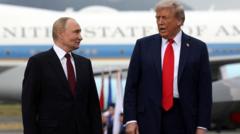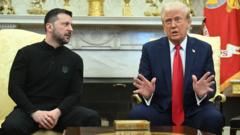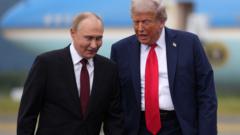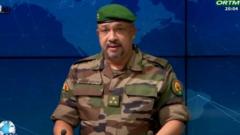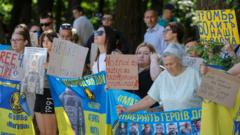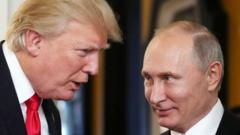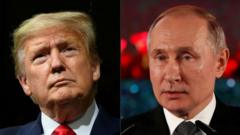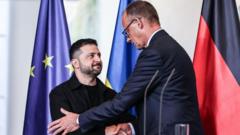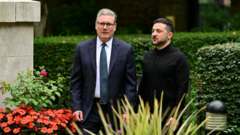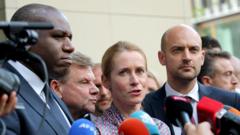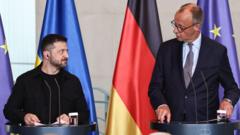**The recent summit between Donald Trump and Vladimir Putin in Alaska concluded without a ceasefire agreement, leaving many uncertainties and repercussions in its wake.**
**Trump-Putin Summit Fails to Deliver Ceasefire in Ukraine**
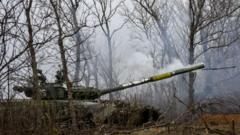
**Trump-Putin Summit Fails to Deliver Ceasefire in Ukraine**
**Leaders depart Alaska without tangible agreements after tense three-hour meeting**
Despite high hopes, the summit between U.S. President Donald Trump and Russian President Vladimir Putin in Alaska has ended in disappointment, as no agreement was reached on a ceasefire in Ukraine. After nearly three hours of discussions, the two leaders provided a joint statement to the media but left without addressing questions, leaving many in the press and onlookers unfulfilled.
Trump's remarks hinted at a lack of progress, with him stating, “There’s no deal until there’s a deal.” His comments served as a concession that the summit did not lead to substantial breakthroughs, leaving Ukraine and the international community in suspense about future negotiations. While America's allies in Europe might breathe a sigh of relief that no unilateral agreements emerged, Trump’s reputation as a skilled negotiator could take a hit, having fostered expectations about the meeting beforehand.
Moreover, analysts noted that Trump appeared to be overshadowed by Putin during the summit, who took the lead in addressing the media. This dynamic raised eyebrows, particularly since the American president tends to dominate similar situations at home. Observations from Anchorage underscored that while Trump aimed to showcase his peacemaker credentials, the absence of a definitive outcome could harm both his domestic and international standing.
Speculations continue regarding Trump's potential sanction responses towards Russia for failing to comply with calls for a ceasefire, with the president stating he may act within the coming weeks. However, critics remain apprehensive about the authenticity of such threats.
On the Russian side, Putin relished the opportunity to command attention alongside Trump, but the outcome revealed a stark divide in their positions regarding the ongoing conflict in Ukraine. While Trump urged for cessation of hostilities, Putin's refusal to commit to a ceasefire suggests a complex geopolitical landscape ahead.
In Ukraine, the lack of a formal deal has brought mixed feelings. While there is relief that no transactions that could endanger territorial integrity were made, there is lingering anxiety concerning Putin's intentions. His reference to addressing the “root causes” of the conflict hints at ongoing threats to Ukrainian sovereignty, raising alarms over potential escalation in military action.
The concluding question emerging from Anchorage is what comes next for Ukraine as the discord persists, with many fearing the likelihood of sustained conflict without a clear path toward resolution. With past Western ultimatums failing to instigate change, the uncertainty lingers dangerously for all affected parties.
Trump's remarks hinted at a lack of progress, with him stating, “There’s no deal until there’s a deal.” His comments served as a concession that the summit did not lead to substantial breakthroughs, leaving Ukraine and the international community in suspense about future negotiations. While America's allies in Europe might breathe a sigh of relief that no unilateral agreements emerged, Trump’s reputation as a skilled negotiator could take a hit, having fostered expectations about the meeting beforehand.
Moreover, analysts noted that Trump appeared to be overshadowed by Putin during the summit, who took the lead in addressing the media. This dynamic raised eyebrows, particularly since the American president tends to dominate similar situations at home. Observations from Anchorage underscored that while Trump aimed to showcase his peacemaker credentials, the absence of a definitive outcome could harm both his domestic and international standing.
Speculations continue regarding Trump's potential sanction responses towards Russia for failing to comply with calls for a ceasefire, with the president stating he may act within the coming weeks. However, critics remain apprehensive about the authenticity of such threats.
On the Russian side, Putin relished the opportunity to command attention alongside Trump, but the outcome revealed a stark divide in their positions regarding the ongoing conflict in Ukraine. While Trump urged for cessation of hostilities, Putin's refusal to commit to a ceasefire suggests a complex geopolitical landscape ahead.
In Ukraine, the lack of a formal deal has brought mixed feelings. While there is relief that no transactions that could endanger territorial integrity were made, there is lingering anxiety concerning Putin's intentions. His reference to addressing the “root causes” of the conflict hints at ongoing threats to Ukrainian sovereignty, raising alarms over potential escalation in military action.
The concluding question emerging from Anchorage is what comes next for Ukraine as the discord persists, with many fearing the likelihood of sustained conflict without a clear path toward resolution. With past Western ultimatums failing to instigate change, the uncertainty lingers dangerously for all affected parties.


